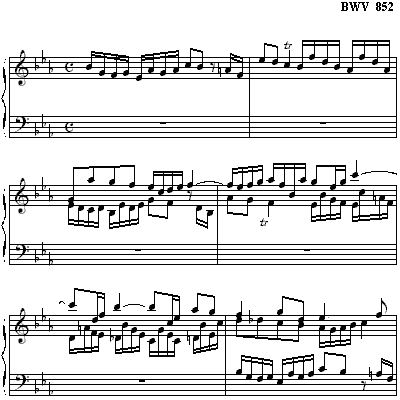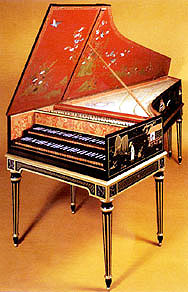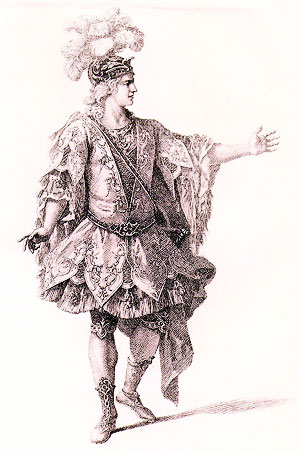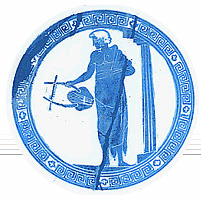|
THE BAROQUE (1600-1750)
| FUGUE |
 |
|
 |
A fugue is a piece of music based on
a highly systematized procedure of imitative
polyphony based on a single theme called a subject.
During the course of a fugue various "voices"
enter in imitative counterpoint much like a
canon or a round.
A fugue is written for a set number
of "voices" which are played by instruments or
sung. It begins with a single voice or
instrument stating the theme (the " fugue
subject") of the piece. The fugue subject comes
in alone by itself in monophonic texture but the
remaining parts of the fugue is in intense
polyphonic texture. Then a second voice takes up
the subject while the first voice continues on
with a new, independent melody, known as a
"countersubject." Then a third voice may take up
the subject while the first two go their
separate ways. There are as many entries of the
fugue theme as there are voices. (Most fugues
are written for two to four voices.) When all
the fugue' voices are going at once, the effect
is that of a conversation between different
melodies, each commenting on or echoing what the
other is saying, while each voice retains its
individual characteristic.
Once all the voices or instruments
have stated the fugue subject, the composer's
challenge is to develop the material of that has
been presented in the most inventive and clever
ways possible. At this point, recurrences of the
theme alternate with passages known as
"episodes." These passages, which are often
derived from fragments of the theme and its
countersubject, provide variety and eventually
lead to new statements of the complete fugue
subject in different keys and registers. These
returning sections are called “restatements."
 |
 |
Young
Bach.
|
The composer's most important and
difficult task in writing a fugue is to maintain
variety and constant interest without
introducing material that is not somehow related
to the fugue subject. During the Baroque period
and forever since the greatest composer of
fugues was Johann Sebastian Bach. He was able to
achieve the complexities of the fugue seemingly
without effort, making his fugues models of
concise inventiveness and profound beauty.
The parts of a fugue are as follows:
 Subject: The theme of a fugue.
The subject starts the fugue in monophonic
texture.
Subject: The theme of a fugue.
The subject starts the fugue in monophonic
texture.
 Exposition: The fugue subject
is announced by all the voices of the fugue in
imitative polyphony.
Exposition: The fugue subject
is announced by all the voices of the fugue in
imitative polyphony.
 Episode: Modulatory passages
built on motivic material drawn from the
subject. There are no complete subject
statements in an episode.
Episode: Modulatory passages
built on motivic material drawn from the
subject. There are no complete subject
statements in an episode.
 Re-statement: Return of the
fugue subject in various keys and modes.
Re-statement: Return of the
fugue subject in various keys and modes.
 Coda: A short ending to the
highly polyphony writing and very often a brief
shift in texture to homophony to tell the
listener the polyphony is coming to a close.
Codas are helpful to conclude a fugue but are
not always present.
Coda: A short ending to the
highly polyphony writing and very often a brief
shift in texture to homophony to tell the
listener the polyphony is coming to a close.
Codas are helpful to conclude a fugue but are
not always present.
Listen to just a Fugue
Subject by J.S. Bach.
Listen to how that Fugue
Subject is imitated and then
developed.

Listen to the Fugue in E
flat, BWV 852 by J.S. Bach. Notice in
the music notation above, how the opening notes
are copied by a lower voice three measures
later.
Listen to a Fugue from the
Well Tempered Clavier by J.S. Bach.
It is played on a modern piano instead of a
harpsichord.
GROUND BASS (continued) |
 |
|
 |
A motive, phrase, or theme in the bass
repeated again and again as the basis for a
composition. A basso continuo is when a bass
instrument that very often plays this bass line
which is reinforced with "continuous" chords or
connecting harmonies played by a harpsichord.
Most Ground Bass forms in the Baroque period had
florid polyphony above the steady Ground.
Certainly that is the case in both "Canon in D"
as well as the "Passacaglia" in C minor by J.S.
Bach.
Listen to the most famous
Ground Bass in Classical Music written by the
Baroque Composer Johann Pachelbel. It is the "Canon"
in D, also known as "Pachelbel's
Canon."
Listen to another Ground
Bass this time by J.S. Bach from his "Passacaglia"
in C minor." Notice how the "ground"
or melody in the bass is stated alone before it
is repeated over and over while the other voices
spin polyphony above it.
| CHAMBER MUSIC |
 |
|
 |
Music
that is performed one person per part is
called Chamber Music. Chamber Music is
different from Orchestral Music because
Orchestral Music (music for an orchestra) has
the parts doubled. For example, if there are
14 first violins in an orchestra then all of
the first violins play the same music,
doubling the parts. When there are 14 second
violins they have different music from the
first violins but together all 14 second
violins play the same music within their
section. In Chamber Music there is only one
person per part.
 |
 |
Baroque
harpsichord.
|
The
most common form of Chamber Music during the
Baroque period was called the Trio
Sonata. A sonata is any
instrumental work in multiple movements. In
the Baroque Era a trio was really an
instrumental work for 4 instruments. Because
the harpsichord was almost always present
accompanying chords in all sorts of Baroque
ensembles it wasn't factored into the genre
Trio Sonata. The typical instruments in a Trio
Sonata are two treble, one bass and one
harpsichord. The harpsichord was the favored
continuo instrument of the Baroque and it
usually accompanied instrumental pieces
playing chords. If a harpsichord wasn't
available then an organ or a Baroque Lute was
used instead. Continuo stands for the
continuous sound of the harpsichord or some
other instrument playing chords.
| OPERA |
 |
|
 |
Drama
presented in music, with the characters singing
instead of speaking. The concept of drama
presented in music came into being during the
Baroque era when musical interludes (intermezzi)
where placed between acts of a play and sung to
the events of the previous or forthcoming act.
Opera grew out of madrigal. Florentine composers
felt that the many voices of a madrigal ensemble
could only dilute strong emotions, not
concentrate them. The Florentines developed a
new style of solo singing that was half music,
half recitation. This led to opera invented in
1600 and it became one of the most important and
characteristic products of Baroque imagination.
It has all of the Baroque ideals of grandeur,
flamboyance and all encompassing art. Opera has
embellished stage sets, elaborate costume design
and often involves not only singers but a chorus
and sometimes dancers.
During the
Baroque period opera had strong divisions
between aria and recitative. The subjects and
story lines were drawn from serious, heroic and
legendary themes. The inspiration for Baroque
opera came from ancient Greece (Opera Seria).
 |
 |
Schwarzenberg collection
of theatralia and theatre repertoir,
costume design,middle 18th century.
|
Aria
- A section of an opera where a singer
gets his or her feelings out in the character
they are portraying. They do this by singing a
soliloquy or meditation based on a recent event
or stirring emotion presented in an opera. A
singer mulling over ones feelings as to ponder
or ruminate an action or emotion. Arias were
accompanied by the orchestra in an opera.
Recitative
- A section in an opera in which a singer
recites words to music. Recitative is more
expressive than ordinary speech but less
melodious (tuneful) than song or aria. It is
like dramatic speech.
| ORATORIO |
 |
|
 |
An opera on a religious
subject. An oratorio is a religious opera and an
oratorio like an opera has soloists, orchestra
and chorus and sometimes also a narrator. Often
oratorios are not staged in that the characters
(singers) are in regular concert attire and not
in costumes. Well known oratorios are Handel's
"Messiah" which is based on the three stages in
the life of Christ, (birth, teaching,
resurrection) and also the "Christmas Oratorio"
by J.S. Bach.
| CANTATA |
 |
|
 |
A one act
religious opera to be performed before the
sermon of the Sunday service. The text in a
cantata is the weekly prayer. Some cantatas
are secular but most are religious. Cantatas
are shorter than Oratorios in that they are
only in one act. Oratorios are in several acts
or parts.
|




